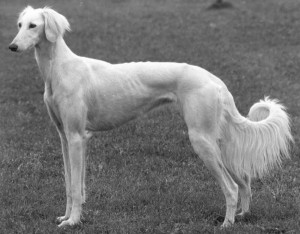By DAN BELKIN, Ph.D.
I WANT YOU TO LEAVE HERE with this idea: things you cannot see are more important than things you can. There are many things about Salukis that a judge can’t see and can’t feel, and functionally, those things are more important than the visible and palpable ones.
I’ll give you an example. The standard says ‘eyes, dark to hazel and bright, large and oval, but not prominent.’ It doesn’t say anything about whether or not the Saluki can see. Laura and I went to England for an entire coursing season and attended all the coursing meetings. While we were there, it was our great pleasure to lead several famous Salukis in the field — Salukis we had seen in books. I noticed that one of them was seeing every hare that entered the field. Hares would come up 300 or 400 yards away and this bitch would turn and look at them. I looked around at the other Salukis that were close to me and none of them were seeing those hares. I could barely see them. Those of you who know dog anatomy know that a dog’s eyes, even a sighthound’s, are not, in general, as good as ours. This Saluki bitch’s eyes were. (She was a Mideast import, by the way; she had not been bred in the UK).
Continue reading The functional Saluki – lessons from the coursing field
